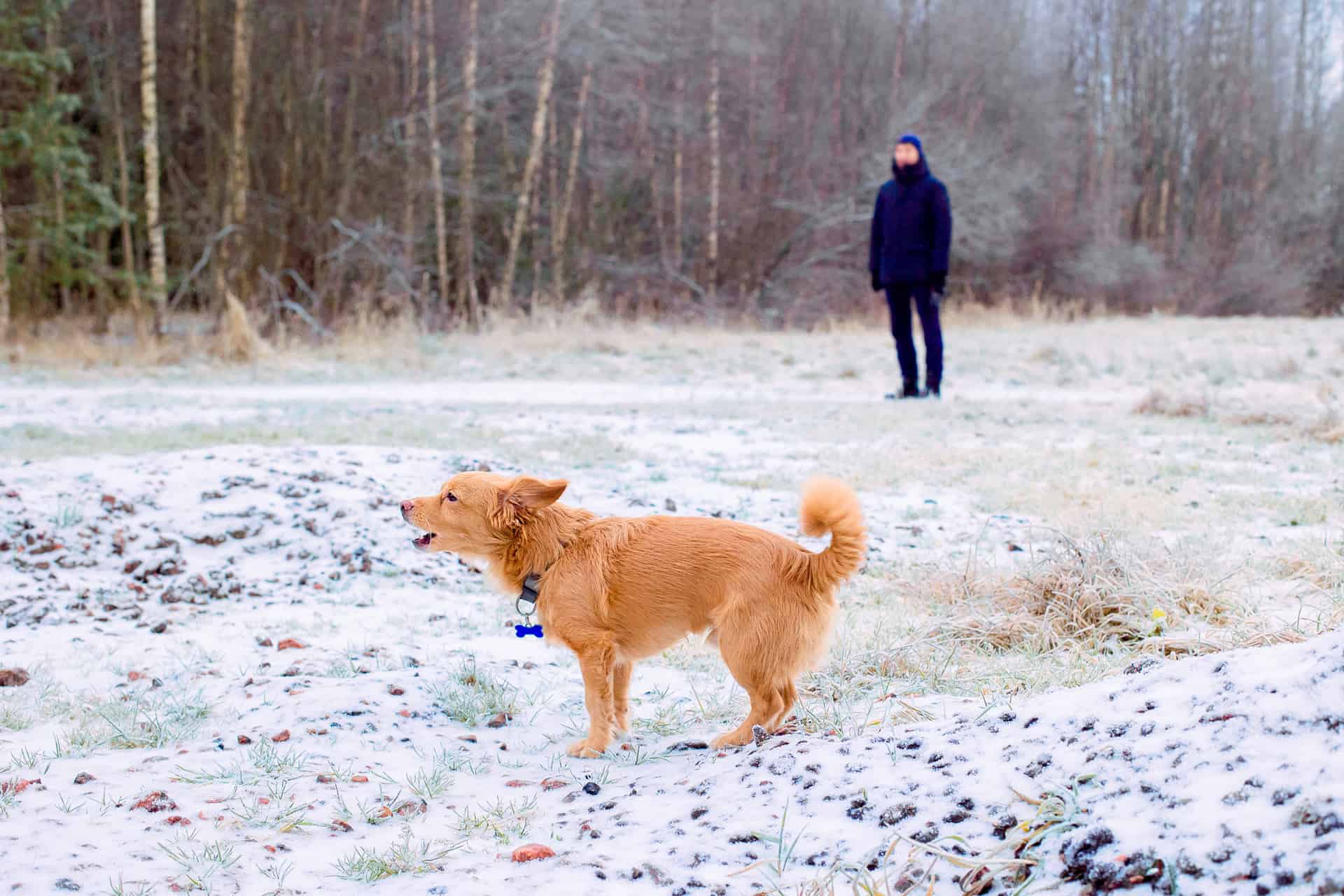Establishing a Consistent Routine to Minimize Barking
Barking can be natural for dogs, but too much can be a pain. To cut down on barking, have a regular routine for your pup. Here’s what to do:
- Feed them regularly.
- Set aside time for play, work-outs and training.
- Have a regular wake and sleep time.
- Be consistent with commands and rewards.
- Even on weekends and holidays, stick to the routine.
This can help your dog feel secure and reduce the anxiety that causes excessive barking.
Understanding Why Dogs Bark
Figuring out why your pooch barks is essential for dealing with barking. Dogs bark for different reasons: to alert us, express joy, or express boredom/loneliness. Knowing the reason for your dog’s barking lets you come up with a consistent system to lower it.
Types of barking: alert, frightened, anxious, bored, attention-seeking, and more
Dogs bark for a variety of reasons. To better understand your pup, it helps to know the types of barking.
Alert Barking: It happens when they spot something unusual, like a stranger near your house or a loud sound.
Fear Barking: This is a protective response when they feel threatened or scared.
Anxious Barking: This is similar to fear barking. It’s when dogs are anxious or nervous, such as when separated from their owner.
Boredom Barking: If a pup has no physical or mental activity, they may bark to release stress and energy.
Attention-Seeking Barking: When they want to play games or get a treat, dogs may bark to get their owner’s attention.
Knowing why your dog barks is the key to dealing with excessive barking. Establishing a routine, exercising them, and providing mental activities can help. Professional help from a trainer or vet might also be needed.
Dog body language
It’s key to understand your pup’s body language. Here are the basics:
- Tail wagging: Fast? Excitement! Low? Aggression!
- Ears: Back? Fear. Up? Alert.
- Posture: Loose? Calm. Stiff? Fearful.
- Eye contact: Staring? Aggression. Averting? Submission.
By grasping your dog’s body language, you can build a strong bond. A consistent routine can minimize barking too. Tip: Use patience and rewards when training your pup. Always prioritize their wellbeing.
Listening to your dog’s vocalizations to interpret what they’re communicating
Interpreting a dog’s vocalizations can be useful. Barking is the most frequent one. Its meaning changes with the pitch, tone and length.
High-pitched and continuous barking may show excitement or anxiety. Short and sharp barks could point to alertness or aggression. Growls may suggest playfulness or aggression depending on the context. Whines or whimpering might mean pain, fear or asking for attention.
By being aware of body language and the situation, one can grasp the vocalization better. Having a regular routine for exercise, training and socialization can reduce barking. Also, training consistently with positive reinforcement can enhance communication with your pup!
Developing a Routine to Minimize Barking
Create a routine for your pup to reduce barking. This will give them a sense of security and ensure they don’t bark. Consistency is key! Maintain a regular schedule. Your pup will soon become familiar with it and may even like it. Let’s learn how to make an effective routine.
Providing daily exercise and mental stimulation
To keep barking to a minimum, a daily routine is key. Here’s what you should do:
- Exercise – Make sure your pup gets enough exercise each day. Walk or run them, play fetch, or involve them in other fun activities.
- Mental Stimulation – Boredom can lead to excessive barking. Give them puzzle games, training sessions, or hide treats for them to find.
- Consistent Routine – Dogs love routine. Establish a consistent daily routine for feeding, exercise, and playtime. Keep the timing the same and reward good behavior.
Pro tip: Exercise and mental stimulation help to reduce barking, anxiety, and improve their behavior.
Feeding your dog on a schedule
Having a schedule for feeding your pup is vital for their mental and physical well-being. This routine minimizes barking, as it takes care of hunger and anxiousness. Here are some advantages of setting a schedule for feeding your pooch:
- Good digestion: Feeding your dog consistently helps keep their digestion in check and stops any tummy ache or messes.
- Aids in training: It’s easier to create a routine for other things, like housebreaking and walks, when you feed them on a schedule.
- Controls weight: Setting regular feeding times helps control their appetite, so they don’t overeat and gain weight.
- Cuts down on barking: A consistent schedule through feeding can reduce any barking caused by stress or anxiety.
Pro tip: Use mealtimes to train and bond with your pup; make them do simple commands before they get their food.
Consistent training and reinforcing good behavior
Training your dog regularly and praising good behavior is essential to stop excessive barking. Developing a routine will help your pup feel secure, which cuts down on their need to bark for attention. To minimize barking, here’s what to do:
- Create a specific feeding time for your dog. This makes them calmer and stops them from begging for food.
- Set aside a certain time for fun and exercise. This gets rid of extra energy that can lead to barking.
- Use positive reinforcement techniques. Give your dog treats when they don’t bark in appropriate situations.
- Do obedience training regularly. This improves your dog’s behavior and communication with you.
- Be patient. It may take time for your pup to learn new behaviors and get used to the routine. Keeping it up and being positive is the key to successfully limiting barking.
Addressing Other Factors That May Contribute to Excessive Barking
Create a regular routine to reduce barking. It’s a good step to solving the problem.
Evaluate other possibilities too, like anxiety, boredom, or insufficient exercise.
Let’s explore how to recognize and take care of these potential causes of barking too much.
Separation anxiety and how to manage it
Separation anxiety in dogs can bring on excessive barking and other destructive habits. To deal with it and lessen barking, it’s important to take into account other factors that could be contributing and make a consistent routine.
Dogs are animals that love being around people. Separation anxiety can arise when they are left alone for long periods, resulting in constant barking, chewing, and digging.
Here are some suggestions to manage separation anxiety and reduce barking:
- Exercise before you go
- Offer a special treat or toy that your dog only gets when it’s time to be alone
- Put together a regular routine to get your dog used to it
- Identify any health or behavioural problems that might be causing the anxiety
With time, patience, and training, you can help manage separation anxiety and reduce barking. Pro tip: Ask for help from an experienced animal behaviourist if you’re having difficulty controlling your dog’s separation anxiety.
Noise sensitivity and desensitization training
Noise sensitivity is a common issue that can cause dogs to bark too much. Desensitization training can help your pooch become calmer with loud noises. Here are the basics:
- Start with a low-volume noise, like a doorbell or phone ringtone.
- Reward your dog with treats and praise when they stay calm.
- Increase the noise volume gradually, still rewarding calmness.
- Keep training short and frequent.
- A routine with regular exercise, meals, and playtime can reduce barking by reducing anxiety.
Pro Tip: Get a pro trainer or behaviorist to make a personalized desensitization plan for your pup. It should be based on their triggers and needs.
Keeping a calm and tranquil home environment
Consistency is key for reducing your pup’s barking and creating a tranquil home. Here are some tips:
- Set a regular feeding schedule and keep to it.
- Designate daily times for walks, playtime, and training.
- No sudden changes in your routine for your dog.
- Give lots of mental and physical stimulation.
- Use positive reinforcement to reward good behavior and stop barking.
Consistency will give your dog security and confidence, and result in a peaceful home.
Tools and Techniques to Help Minimize Barking
Creating a routine for meals, workouts and play is essential for cutting down your pup’s barking. Having a set schedule teaches them the home pattern and when they will get attention. There are other methods and tools to quiet your four-legged friend.
Let’s explore some of the choices:
Anti-bark collars and sprays
Anti-bark collars and sprays are designed to reduce barking in dogs. They can be electric or citronella-based. Electric collars deliver a shock, and citronella collars release mist. Anti-bark sprays also work, with an unpleasant scent or sound.
The best way to minimize barking is establishing a routine. Exercise, mental stimulation, and rewards for good behavior. With patience, most dogs can learn to bark less.
Pro Tip: Use anti-bark collars and sprays carefully. Get advice from a professional trainer or vet.
White noise machines, calming music, and other sound-based solutions
Reduce your dog’s barking with sound-based solutions like white noise machines and calming music. And create a consistent routine for walking, feeding, playing, and sleeping. Place the white noise machine close to your pup’s sleeping area. Play calming music in the background. Keep to a regular schedule each day for structure and security. Plus, train them to respond to commands like “quiet” or “enough”. And reward them with treats or praise when they obey.
Engaging with your dog in a positive and interactive way
Strengthen your bond with your pup by engaging in positive and interactive ways. Here’s how:
- Interactive Toys – there are heaps of toys to choose from that’ll keep your pup stimulated.
- Training Games – teach tricks, like fetch and hide-and-seek, to help focus their energy.
- Exploring Nature – take your pup on a walk or hike to engage with them while they exercise.
- Positive Reinforcement – offer treats or praises when your pup displays good behaviour.
- Consistent Routine – setting up a routine for feeding, exercising and playtime will reduce barking due to stress or anxiety.
When to Seek Professional Help
Know when to seek help for barking dogs. If your pup’s barking is disruptive and recurrent, it’s time to chat with a vet or pro dog trainer. They’ll offer tailored tips and guidance. This will help you and your pup get back on track!
Signs that your dog’s barking may be indicative of an underlying problem
Barking is a natural way for dogs to communicate. But, too much or unusual barking can mean there’s a problem. Here are signs that there may be an issue:
- Constant barking or whining, especially if it’s out of character for your pup.
- Getting aggressive towards people or other animals.
- Barking with other worrying behaviors such as being slow, not eating, or being anxious.
If your pup is showing any of these signs, you should talk to a vet or a certified dog behaviorist. Having a routine with regular exercise, meals and playtime can help reduce barking and other bad behaviors. Doing this can help build a healthier and happier relationship between you and your pup.
Consulting with a veterinarian or animal behaviorist
Creating a regular routine can help reduce your pup’s barking. If you have tried other methods and the barking continues, it may be time to see a vet or animal behaviorist.
The vet can check if there are any medical concerns causing the barking, such as pain or stress. The behaviorist can figure out why the dog is barking and create a plan specific to them.
If the barking is too much, intense, or disturbing neighbors, then professional help is a must. Getting help now can help your pup stop barking and prevent future behavioral issues.
Pro tip: Make sure to choose a certified and experienced expert with a positive attitude for your dog’s safety.
Training sessions with a professional dog trainer
Having trouble getting your pup to stop barking? Consult a professional dog trainer. They can help with specific behavior issues and come up with a training plan that uses positive reinforcement. Here are some benefits of working with a pro:
- Personalized attention for your needs.
- Expertise to figure out the root cause of your pup’s barking and provide tailored solutions.
- Everyone in your family will be on the same page.
- The trainer will use successful techniques to reward good behavior and stop bad habits.
Every dog is different, so results may vary. But with help from a professional, you can create a consistent routine and reduce the barking. This can bring peace and happiness to your home.
Frequently Asked Questions
1. What is the best way to establish a consistent routine to minimize barking in my dog?
The best way to establish a consistent routine to minimize barking is to establish a routine for your dog’s feeding, exercise, and potty breaks. Stick to the same schedule every day and make sure your dog gets plenty of exercise which will help relieve anxiety and reduce barking.
2. How long does it take to establish a routine to minimize barking in my dog?
It can take anywhere from a few days to several weeks to establish a consistent routine with your dog. The key is to remain consistent and patient. If you stay committed to the routine, your dog should start to understand what is expected of them and when they can expect their needs to be met.
3. Can using treats help establish a consistent routine to minimize barking in my dog?
Yes, using treats as part of a positive reinforcement training plan can help establish a consistent routine to minimize barking in your dog. When your dog follows the routine and doesn’t bark excessively, reward them with a treat
4. Will training help minimize barking in my dog?
Yes, training can definitely help minimize barking in your dog. Positive reinforcement training can help train your dog to follow a consistent routine and understand what is expected of them. This can help reduce anxiety and barking caused by confusion.
5. Are there any other benefits to establishing a consistent routine for my dog?
Yes, there are many benefits to establishing a consistent routine for your dog. Some of the benefits include a reduction in anxiety and stress, improved digestion, and increased socialization skills.
6. Is it important to be consistent with my dog’s routine?
Yes, consistency is key when it comes to establishing a routine for your dog to minimize barking. Dogs thrive on routine and knowing what to expect. If you are inconsistent, it can confuse your dog and lead to more barking and anxiety.







